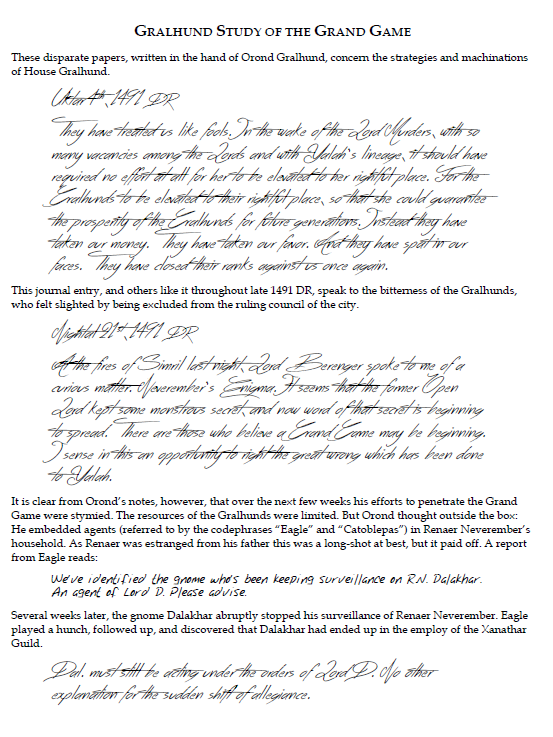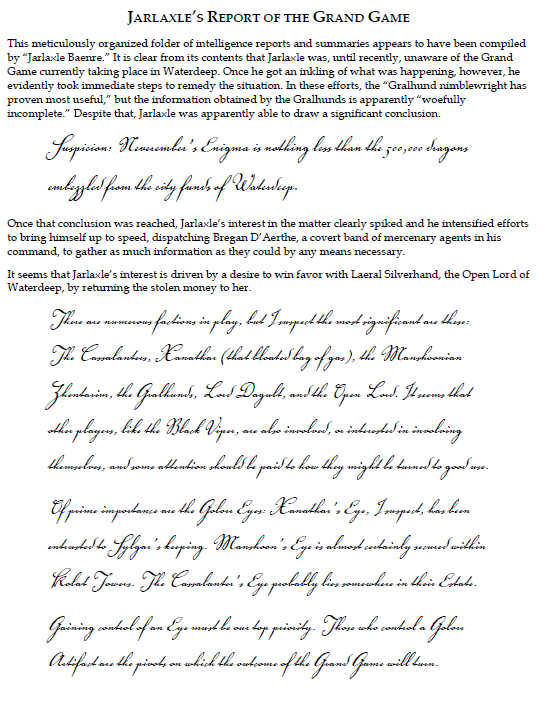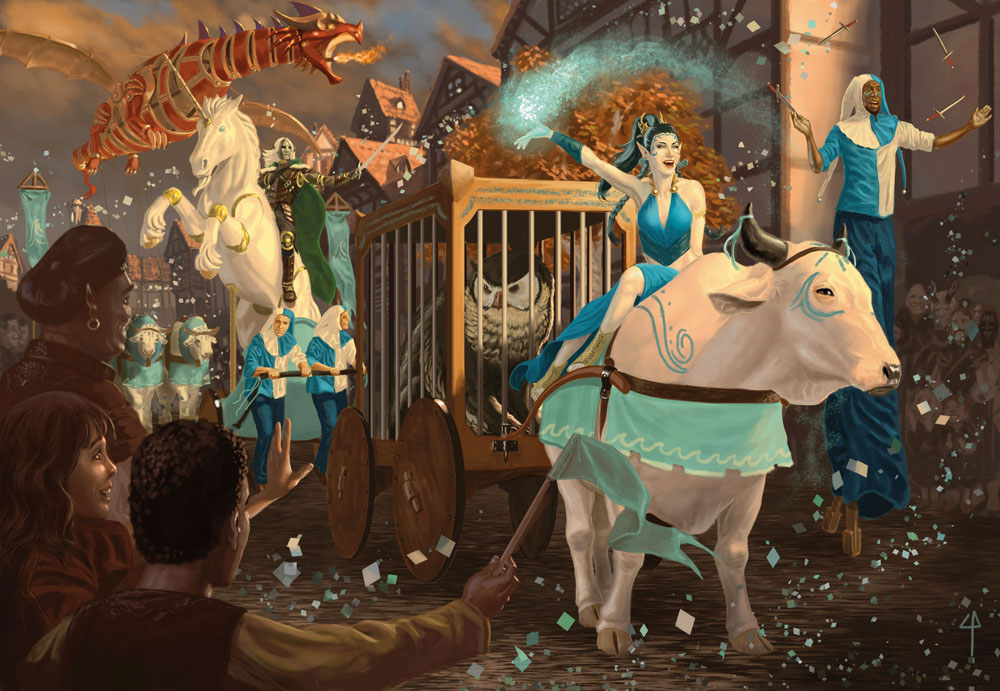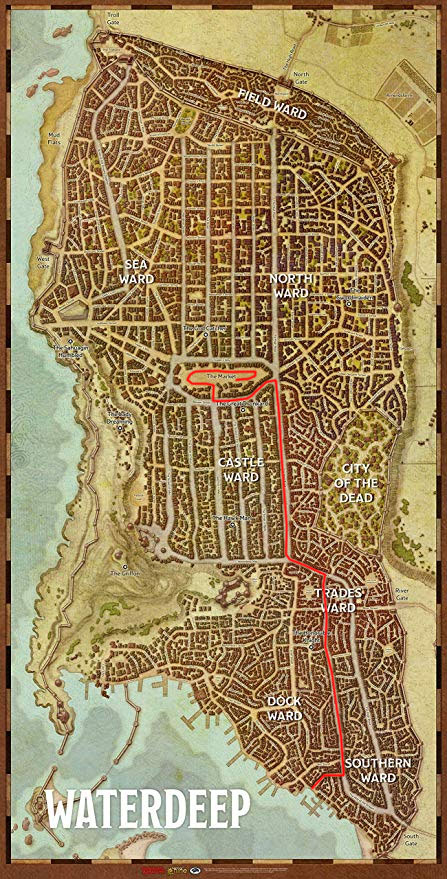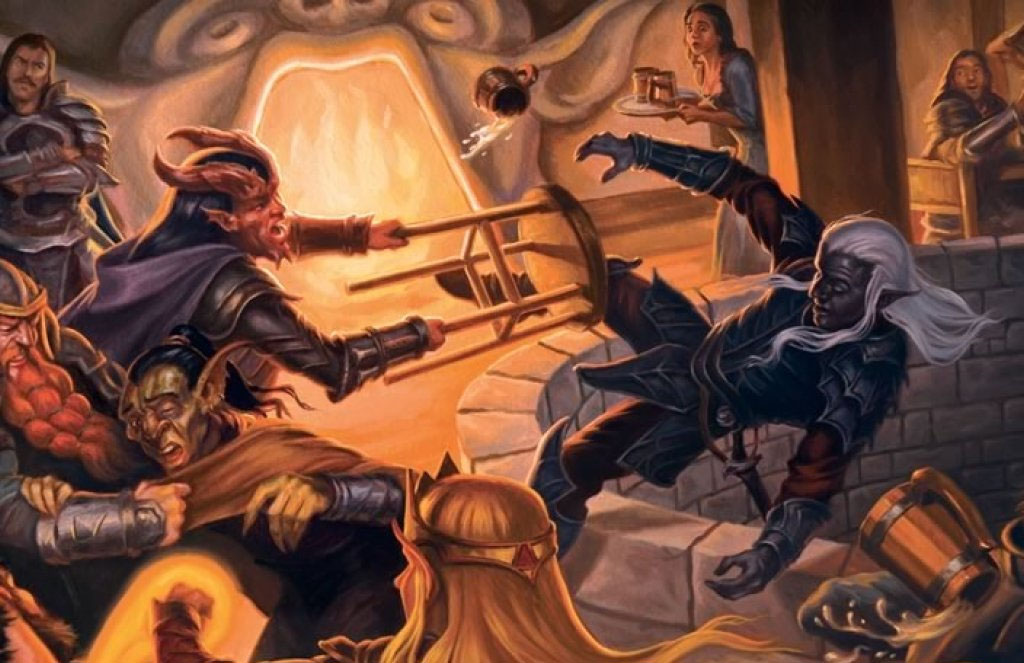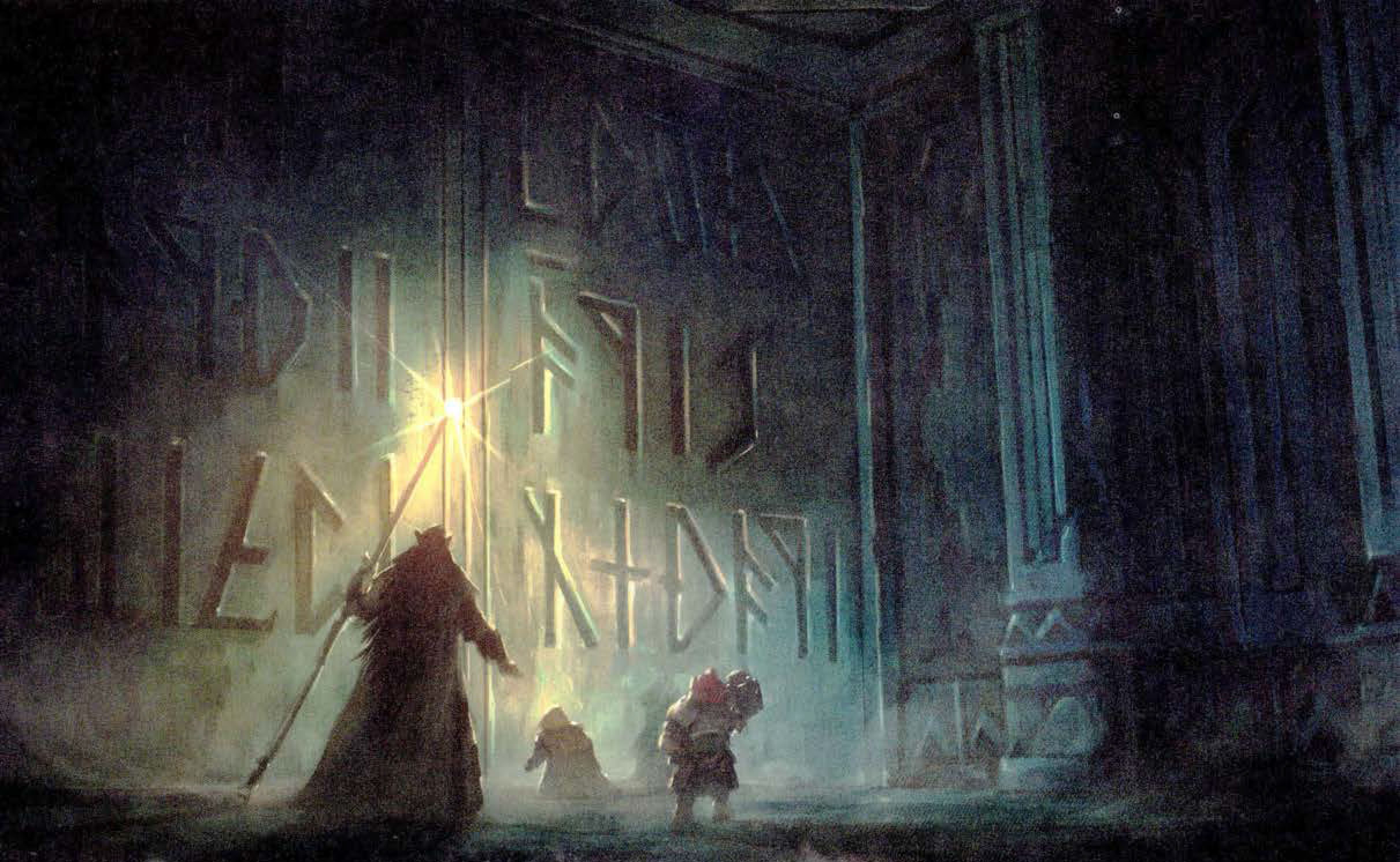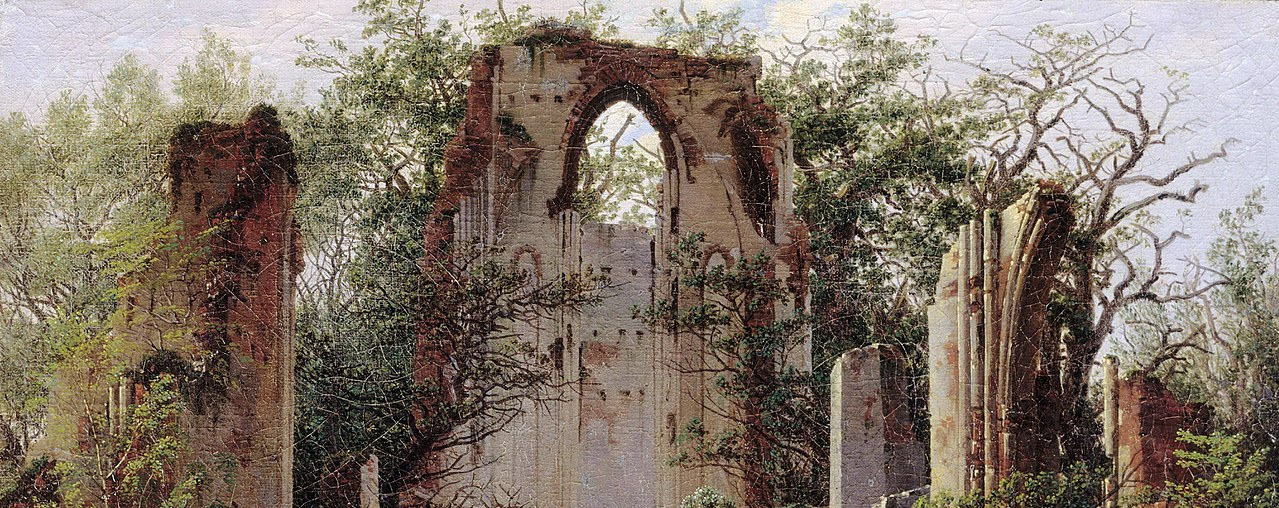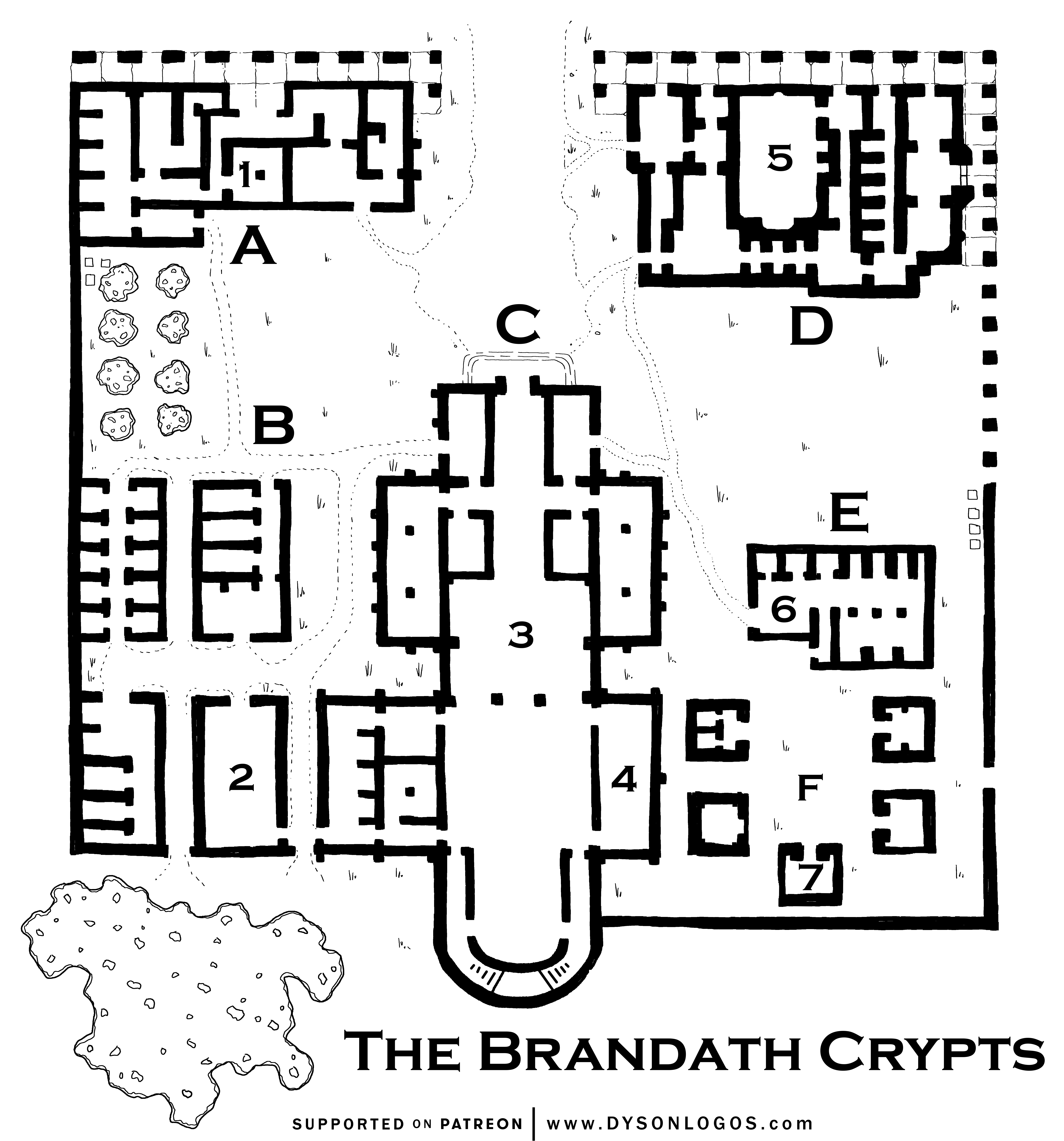
These lengthy reports, which can be discovered within the various facton lairs, are designed to be given to the players as handouts. They provide the PCs an opportunity to peer deeper into the machinations of the Grand Game, and can also serve as a reference for the GM to figure out what knowledge each faction currently has (and which its agents might surrender under questioning).
The reports here do not necessarily reflect the knowledge held by each faction at the very beginning of Dragon Heist. They have been written to reflect the state of the reports at the time the PCs are most likely to encounter them (during the Eye Heists). During earlier events, the factions may still be trying to piece together some of this information. (Most notably, if the PCs stage a heist at the Sea Maidens Faire without tipping off Jarlaxle about the Grand Game, there won’t be any report as he will not yet be involved in the Grand Game.) As the events of the campaign develop, you may also want to update these reports to reflect ongoing events (including explicit or implicit references to the activities of the PCs).
You’ll note that each faction refers to the Eyes using a different nomenclature. This complicates things slightly for the players (who need to figure out which names equate to which names), but not significantly. The real point of this is to deepen verisimilitude: These factions don’t all compare notes. Each faction has a unique perspective on the Grand Game, and allowing the players to see that in practical ways will make it clear that the game world is a dynamic, interactive place, not a monolithic entity.
As a quick reference, when the PCs get drawn into the Grand Game:
- The Stone of Golorr was stolen by Xanathar. It was taken from Xanathar by Dalakhar, and taken from Dalakhar by the Gralhunds.
- Xanathar’s Eye was originally stolen by the Zhentarim from the Protector’s Enclave in Neverwinter. Xanathar slew a Zhentarim embassy and took the Eye.
- The Zhentarim Eye was taken from Renaer’s mourning locket.
- The Cassalanter Eye was taken from the crypt of Lady Alethea Brandath.
The reports are presented in both plain text and also as PDFs with fancy handwriting fonts.
GRALHUND STUDY OF THE GRAND GAME
These disparate papers, written in the hand of Orond Gralhund, concern the strategies and machinations of House Gralhund.
Uktar 4th, 1491 DR
They have treated us like fools. In the wake of the Lord Murders, with so many vacancies among the Lords and with Yalah’s lineage, it should have required no effort at all for her to be elevated to her rightful place. For the Gralhunds to be elevated to their rightful place, so that she could guarantee the prosperity of the Gralhunds for future generations. Instead they have taken our money. They have taken our favor. And they have spat in our faces. They have closed their ranks against us once again.
This journal entry, and others like it throughout late 1491 DR, speak to the bitterness of the Gralhunds, who felt slighted by being excluded from the ruling council of the city.
Nightal 21st, 1491 DR
At the fires of Simril last night, Lord Berenger spoke to me of a curious matter. Neverember’s Enigma. It seems that the former Open Lord kept some monstrous secret, and now word of that secret is beginning to spread. There are those who believe a Grand Game may be beginning. I sense in this an opportunity to right the great wrong which has been done to Yalah.
It is clear from Orond’s notes, however, that over the next few weeks his efforts to penetrate the Grand Game were stymied. The resources of the Gralhunds were limited. But Orond thought outside the box: He embedded agents (referred to by the codephrases “Eagle” and “Catoblepas”) in Renaer Neverember’s household. As Renaer was estranged from his father this was a long-shot at best, but it paid off. A report from Eagle reads:
We’ve identified the gnome who’s been keeping surveillance on R.N. Dalakhar. An agent of Lord D. Please advise.
Several weeks later, the gnome Dalakhar abruptly stopped his surveillance of Renaer Neverember. Eagle played a hunch, followed up, and discovered that Dalakhar had ended up in the employ of the Xanathar Guild.
Dal. must still be acting under the orders of Lord D. No other explanation for the sudden shift of allegiance.
Contemporary notes from other sources allowed Orond to begin piecing certain facts about the Grand Game and Neverember’s Enigma.
There are Three Eyes with which Neverember’s Enigma may be seen. The First Eye is held by Xanathar, and lies somewhere within his lair. Bulette’s report that this lair can be accessed from teleportal sites within X’s sewer hideouts provides a potential means by which this Eye could seized, but in the absence of a synchronized key these teleportal sites are useless.
A later note states:
The Second Eye has almost certainly been taken from R.N by the Zhentarim. It is more important than ever that we discover where M has hidden his head.
And then, this:
Xanatharians are riled. Word on the street is that something was stolen from them. But not the First Eye. The stone of Golorr.
This report is attached to analysis written be Orond.
What if the “Key to Neverember’s Enigma” which Xanathar was known to hold in his possession is not, as I have suspected, the Eye? But instead the Stone of Golorr?If so, then what better thief than an agent of Dagult’s? Perhaps even sent there for that purpose. The gnome has taken the Stone, I am certain of it. If we can find Dalakhar, then we can seize the Key. We can take the Stone.
JARLAXLE’S REPORT ON THE GRAND GAME
This meticulously organized folder of intelligence reports and summaries appears to have been compiled by “Jarlaxle Baenre.” It is clear from its contents that Jarlaxle was, until recently, unaware of the Grand Game currently taking place in Waterdeep. Once he got an inkling of what was happening, however, he evidently took immediate steps to remedy the situation. In these efforts, the “Gralhund nimblewright has proven most useful,” but the information obtained by the Gralhunds is apparently “woefully incomplete.” Despite that, Jarlaxle was apparently able to draw a significant conclusion.
Suspicion: Neverember’s Enigma is nothing less than the 500,000 dragons embezzled from the city funds of Waterdeep.
Once that conclusion was reached, Jarlaxle’s interest in the matter clearly spiked and he intensified efforts to bring himself up to speed, dispatching Bregan D’Aerthe, a covert band of mercenary agents in his command, to gather as much information as they could by any means necessary.
It seems that Jarlaxle’s interest is driven by a desire to win favor with Laeral Silverhand, the Open Lord of Waterdeep, by returning the stolen money to her.
There are numerous factions in play, but I suspect the most significant are these: The Cassalanters, Xanathar (that bloated bag of gas), the Manshoonian Zhentarim, the Gralhunds, Lord Dagult, and the Open Lord. It seems that other players, like the Black Viper, are also involved, or interested in involving themselves, and some attention should be paid to how they might be turned to good use.
Of prime importance are the Golorr Eyes: Xanathar’s Eye, I suspect, has been entrusted to Sylgar’s keeping. Manshoon’s Eye is almost certainly secured within Kolat Towers. The Cassalanter’s Eye probably lies somewhere in their Estate.
Gaining control of an Eye must be our top priority. Those who control a Golorr Artifact are the pivots on which the outcome of the Grand Game will turn.

